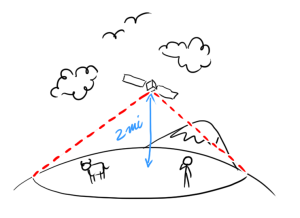Before I read that Elon Musk’s insanely-huge satellite fleet was to orbit at around 1100 kilometers above the Earth, I did some back-of-the-envelope math to figure out what satellite altitude would be necessary to carpet the planet with coverage. From this came an interesting little exercise in hypothetical logistics.
First, figuring the minimum altitude of a 4,000 station constellation: We can use a formula for the fraction of the Earth visible from a point:
\(A = \frac{1}{2} \left( 1 – \frac{R_e}{R_e + h} \right)\)
…where \(R_e\) is the radius of Earth, \(h\) is the altitude of the observer, and \(A\) is a fraction of the Earth’s surface area. We can divide up the Earth into 4000 pieces and solve for h to know how high a satellite must be to see its portion of the Earth. When we do this, we get…
1.98 miles high.
If you want to blanket the entire planet with internet coverage, and you’ve got 4000 things to do it with, those things only need to be floating about 2 miles off the ground!
Obviously nobody’s putting satellites in two-mile orbits. And we’d like some redundant coverage, so let’s demand that every point on Earth be covered by at least three stations and try again. What do we get?
2.97 miles. (We don’t need much extra altitude because the visibility increases most quickly near Earth’s surface).
So if we’re going to buy 4000 of something, why not make them balloons?
I was interested in this question, since at first blush a balloon seems a lot cheaper than a satellite, and the idea of internet-serving balloons is not a new one. Also, if we confine coverage to land area only, we could drop the number of required stations by 70%.
By my figuring, it’s for a couple reasons that this isn’t done.
There are three ways you could manage a balloon’s coverage: You could tether it, you could keep it in place with a powered motor, or you could let it drift with prevailing winds.
Tether
 A single one-inch-wide, three-mile-long steel tether would weigh about 55,000lbs. We can find out how big a balloon we’ll need with this formula:
A single one-inch-wide, three-mile-long steel tether would weigh about 55,000lbs. We can find out how big a balloon we’ll need with this formula:
\(R_{balloon} = \sqrt[3]{\frac{3}{4 \pi} \frac{m_{lift}}{0.69}}\)
…which relates the lift mass to the required radius of a helium balloon at 2 miles altitude. From this, we find that the size of a helium balloon required to keep three such tethers aloft would be a minimum of 230 feet across.
Inflating our fleet would take about as much helium as the entire world uses in one year. The 50 mph wind on such a balloon at the requisite 15,000 feet altitude would add another 18,000 pounds of force to the tethers. And if the balloon bursts in a storm, you’ve got three miles of steel cable falling on a possibly populated area.
OK, not looking so great. And that’s before we start factoring in the cost of raising and anchoring the balloons, getting land rights for the anchors, getting government permission to hang miles of steel cable over everyone’s heads, and the inevitability that only balloons over populated areas will be profitable, thus cutting out potential customers in rural or remote areas (which is a major target market for Musk— largely unserved at present).
OK, forget the tether.
Powered
 Right away, we can do away with a ton of weight. We’ll assume the amount of comm equipment needed for a station weighs about as much as an iridium satellite, which is 700kg. Let’s double this weight for engines and balloon weight to be on the conservative side. We can use our buoyancy formula to get a balloon size, and then plug that into the drag equation (assuming a \(C_d\) of 0.04, a conservative value for a streamlined airship, and 50 mph winds), to ask how much force the wind will exert— and therefore how much thrust we’ll need to oppose it. This comes out to about 150 horsepower. Not too bad, but where do we get the energy?
Right away, we can do away with a ton of weight. We’ll assume the amount of comm equipment needed for a station weighs about as much as an iridium satellite, which is 700kg. Let’s double this weight for engines and balloon weight to be on the conservative side. We can use our buoyancy formula to get a balloon size, and then plug that into the drag equation (assuming a \(C_d\) of 0.04, a conservative value for a streamlined airship, and 50 mph winds), to ask how much force the wind will exert— and therefore how much thrust we’ll need to oppose it. This comes out to about 150 horsepower. Not too bad, but where do we get the energy?
Solar seems attractive, since no refueling is required, but at a typical PV panel output of 250 watts/m², and assuming we harvest at, say, 4x our engine output (to recharge for nighttime and overcast days) we’ll need 1700m² of PV arrays. That’s way too big. Even if solar panels were suddenly cheap and efficient enough, if we wanted to store more than 24 hours of energy, we’d need 125 Tesla Model S battery packs. Which would weigh 137,000 lbs. And cost God Knows how much.
Powered balloon is out.
Drifting
 An untethered, unpowered, low-altitude balloon would be very vulnerable to weather and terrain, and would probably not stay aloft for long. Google’s internet balloon project gets around this by floating the balloons at 100,000 ft instead. We no longer have the luxury of confining our coverage to the landmass of Earth, because we don’t control the position of the balloon— we’d have to rely on there simply being enough of them to randomly cover the service area at any given moment. (This is already not looking so good). 4000 high-altitude balloons gives us about 10x coverage of the Earth’s area.
An untethered, unpowered, low-altitude balloon would be very vulnerable to weather and terrain, and would probably not stay aloft for long. Google’s internet balloon project gets around this by floating the balloons at 100,000 ft instead. We no longer have the luxury of confining our coverage to the landmass of Earth, because we don’t control the position of the balloon— we’d have to rely on there simply being enough of them to randomly cover the service area at any given moment. (This is already not looking so good). 4000 high-altitude balloons gives us about 10x coverage of the Earth’s area.
One problem with high-altitude balloons is that the lifting capacity of a balloon decreases at higher altitudes, since the displaced mass of the air (i.e. the force responsible for holding the balloon aloft) becomes less and less. At 100,000 feet, a balloon’s lifting capacity is about 1% of that near sea level. This means a balloon of the same size as the examples above could lift just a few kilograms— Google’s project weighs their equipment at 10kg; a serious limitation when compared to a satellite’s capability.
A generously light comsat of 300kg would require a 110-foot balloon. This, too, is a lot of helium— If the balloons are relaunched every 20 days (per Google’s schedule), it’s 1/6th of the Earth’s yearly helium usage. And all for a high-maintenance network whose coverage is uncontrollable and subject to prevailing winds.
So even though “a ton of satellites” sounds expensive, it’s clearly the only serious option for global, stable coverage, though the unconventional alternatives are fun to contemplate.
So how do satellites compare?
If we can get full Earth coverage at 2 miles altitude, what does 1100km get us? In other words, if we use the land coverage formula above, how many times over does Elon Musk’s satellite network cover the Earth?
The answer is 280 times. So, on average, at any given moment, 280 SpaceX internet satellites will be visible in the sky. In fact it may actually be more, because coverage will be concentrated away from the poles.
As for why Musk needs such redundancy, I’d guess it’s a bandwidth requirement, and having more satellites (rather fewer, more complicated ones) will allow each one to be lighter and cheaper.
In the mid twentieth century, Earth’s sky changed suddenly as commercial air traffic started to become a common and conspicuous sight. Perhaps Musk’s mega-fleet might do something similar to the early evening sky— look up in five to ten years, and you’ll see 200+ satellites twinkling above you.






